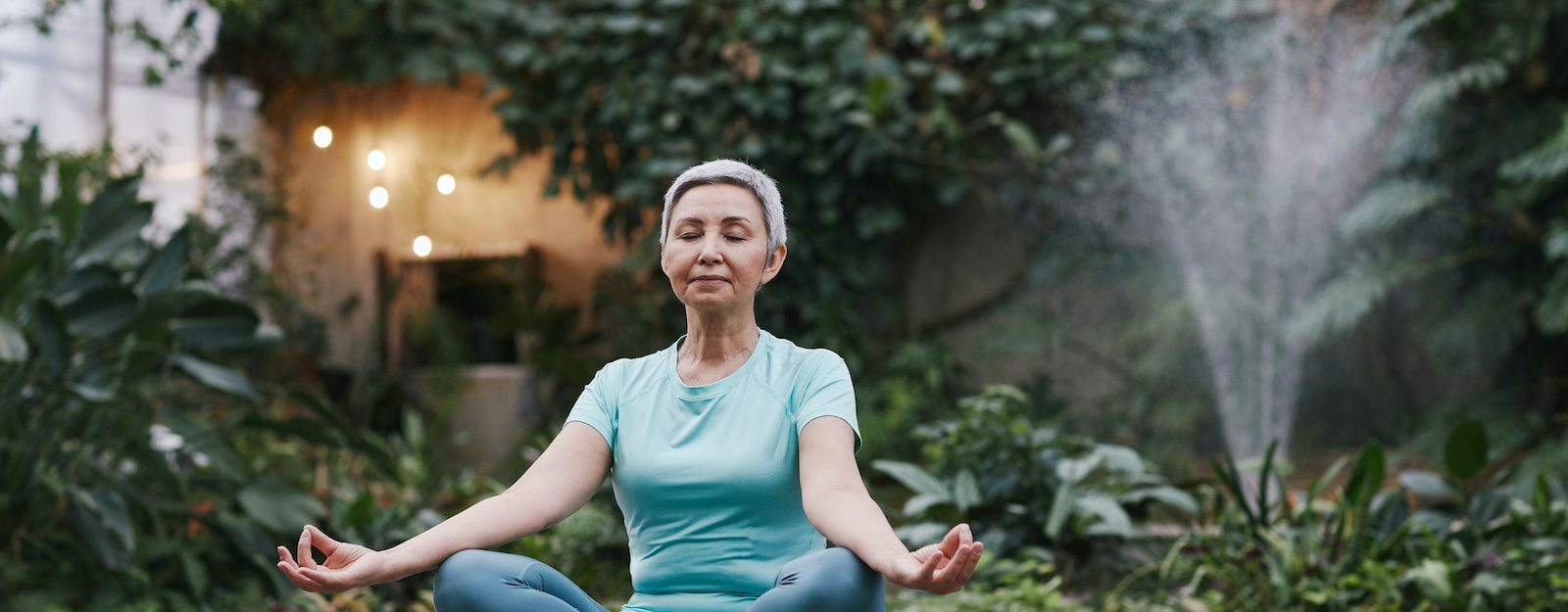There are many breathing techniques to choose from with benefits that range from stress reduction to improved mental health. This article explains four breathing approaches to try and why a regular breathing practice may help support your overall health.
Why is Breathing in a Specific Way Important?
The first three techniques (4-7-8 Breath, Alternate Nostril Breathing, and Yoga Nidra) are designed to help reduce stress. That’s key because unchecked stress is known to contribute to many health conditions, including depression and heart disease.
During stressful or anxiety-inducing moments your breathing pace may become quick and shallow. This activates your body’s “fight or flight” response, which over time can weaken immunity, raise blood pressure, and up the risk of type 2 diabetes and obesity. Breathing techniques counter stress by stimulating your body’s “rest and digest” response, which protects your health.
The final technique called the Wim Hof Method, may help you feel more connected to yourself and to your surroundings and improve feelings of self-fulfillment. We encourage you to explore how each method resonates with you and experiment with when to use them to keep yourself in balance.
4-7-8 Breath
This technique, invented by Dr. Andrew Weil, refers to a pattern of breathing that involves inhaling, holding your breath, and then exhaling with specific timing.
To start, bring the tip of your tongue to the roof of your mouth until it touches the ridge of tissue behind your front teeth. Your tongue placement will remain here throughout the process. Note that you will exhale through your mouth by pursing your lips and making a “whoosh” sound. Follow these steps to continue:
- Fully exhale through your mouth.
- With your mouth closed, inhale through your nose for 4 counts.
- Hold your breath for 7 counts.
- Exhale for 8 counts.
Optimally, practice 4 breathing cycles twice per day.
Alternate Nostril Breathing
In Sanskrit, this breathing technique is called nadi shodhana. “Nadi” translates to channel and “shodhana” translates to purifying. Alternate nostril breathing for 15 minutes per day for 6 weeks has been shown to significantly improve stress.
Practicing nadi shodhana involves using your right hand to guide your breath. You may also rest your index and middle fingers between your eyebrows. Follow these steps to continue:
- Use your thumb to gently close your right nostril. Breathe in for 3 counts through your left nostril.
- Gently close your left nostril with your ring finger. Release your thumb to exhale through your right nostril for 3 counts.
- Keep this same hand position to inhale through your right nostril for 3 counts.
- Gently close your right nostril with your thumb. Release your ring finger to exhale through your left nostril for 3 counts.
- Repeat steps 1-4.
Yoga Nidra
The goal of yoga nidra is to reach complete relaxation. In Sanksrit, “yoga” translates to union and “nidra” translates to sleep. Two studies have confirmed measurable changes in the central nervous system and an increase in the “happy hormone” known as dopamine when yoga nidra is practiced for 30 minutes per day for two weeks to 6 months.
To achieve this practice, which involves a rested mind and body while your consciousness is awake, you can follow a YouTube video or guide yourself through the 10 stages of yoga nidra. To get started, find a restful position. Lie on your back on a yoga mat, blanket, couch, bed, or wherever you feel comfortable. Use pillows and bolsters as needed to support your neck and knees. You may wish to cover your body with a blanket. Here’s how to continue through the steps, according to the yoga scholar Dr. Richard Millar:
- Connect to your heart’s deepest desire: What is your top health goal? Imagine accomplishing this goal and how good it will feel.
- Set an intention: What is your reason for practicing today? It can be anything that comes to mind. Center your practice around this reason.
- Find your inner resource: This stage is realized when your body can relax into a comfortable, safe space. To help, think of a person, place, or experience that allows you to feel at ease.
- Scan your body: Focus your awareness at the top of your head and then progress all the way to the tips of your toes. As you navigate through each body part notice how your body eases into a deeper, relaxed state.
- Become aware of your breath: Observe how your body reacts to each breath. Pay attention to the way your belly rises and falls in response to your inhalations and exhalations. Notice that the air is cooler when you inhale, and warmer when you exhale. This awareness can help regulate your breathing.
- Welcome your feelings: Label how you feel and be honest. Feelings can be broken down into three categories (positive, negative, and neutral). You don’t need sugarcoat how you feel. Allow yourself to sit with your emotions, as if you are welcoming a friend to sit with you.
- Witness your thoughts: This stage is like step 6. Without judgement, notice what you are thinking. You may have positive, negative, or neutral thoughts. As you welcome these thoughts, especially if they are negative, consider how it feels to explore opposing thoughts.
- Experience joy: As you exhale, you may feel the warmth of your breath diffusing through your body. If you feel sensations of bliss, happiness, and joy, let them radiate throughout your whole being.
- Observe your “self”: This stage is simply asking…how do you feel? It will allow you to wake up with a sense of connection to your emotions. Tap into your feelings using “I” statements (for example I feel at peace, I feel frustrated, I feel happy).
- Reflect on your practice: As you conclude your practice, again notice how you feel. Take a moment to imagine how you can bring feelings of peace into your everyday life, whether a situation is positive or challenging. Before you open your eyes and transition into a wakeful state, take a moment to focus on gratitude.
Wim Hof Method
This method involves hyperventilation followed by periods of holding your breath, which has been shown to improve emotional well-being.
To practice the Wim Hof Method, start in a relaxed position. Follow these instructions to cycle through the 3 rounds for this technique:
- Round 1: Breathe in for 2 seconds and out for 2 seconds 30 times. After exhaling completely, hold your breath for 30 seconds.
- Round 2: Breathe in for 2 seconds and out for 2 seconds 30 times. After exhaling completely, hold your breath for 1 minute.
- Round 3: Breathe in for 2 seconds and out for 2 seconds, 30 times. After exhaling completely, hold your breath for 1 minute and 30 seconds.
Note: If you have concerns about starting a breathing practice or which one is right for you, talk to a medical professional. If you try a breathing technique and you feel the need to stop at any time, ease out of the practice, resume normal breathing, and discuss the experience with your doctor.

